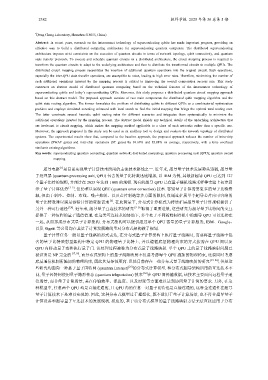Page 482 - 《软件学报》2025年第5期
P. 482
2382 软件学报 2025 年第 36 卷第 5 期
4
(Peng Cheng Laboratory, Shenzhen 518055, China)
Abstract: In recent years, research on the interconnect technology of superconducting qubits has made important progress, providing an
effective way to build a distributed computing architecture for superconducting quantum computers. The distributed superconducting
architecture imposes strict constraints on the execution of quantum circuits in terms of network topology, qubit connectivity, and quantum
state transfer protocols. To execute and schedule quantum circuits on a distributed architecture, the circuit mapping process is required to
transform the quantum circuits to adapt to the underlying architecture and then to distribute the transformed circuits to multiple QPUs. The
distributed circuit mapping process necessitates the insertion of additional quantum operations into the original circuit. Such operations,
especially the inter-QPU state transfer operations, are susceptible to noise, leading to high error rates. Therefore, minimizing the number of
such additional operations inserted by the mapping process is critical to improving the overall computation success rate. This study
constructs an abstract model of distributed quantum computing based on the technical features of the interconnect technology of
superconducting qubits and today’s superconducting QPUs. Moreover, this study proposes a distributed quantum circuit mapping approach
based on this abstract model. The proposed approach consists of two main components the distributed qubit mapping algorithm and the
qubit state routing algorithm. The former formulates the problem of distributing qubits to different QPUs as a combinatorial optimization
problem and employs simulated annealing enhanced with local search to find the initial mapping that brings the optimal total routing cost.
The latter constructs several heuristic qubit routing rules for different scenarios and integrates them systematically to minimize the
additional operations inserted by the mapping process. The abstract model shields any technical details of the underlying architecture that
are irrelevant to circuit mapping, which makes the mapping method applicable to a class of such networks rather than a specific one.
Moreover, the approach proposed in this study can be used as an ancillary tool to design and evaluate the network topology of distributed
systems. The experimental results show that, compared to the baseline approach, the proposed approach reduces the number of intra-chip
operations (SWAP gates) and inter-chip operations (ST gates) by 69.69% and 85.88% on average, respectively, with a time overhead
similar to existing algorithms.
Key words: superconducting quantum computing; quantum network; distributed computing; quantum processing unit (QPU); quantum circuit
mapping
超导电路 [1] 是目前实现量子计算技术所用的主流技术路线之一. 近年来, 超导量子技术发展势头迅猛, 超导量
子处理器 (quantum processing unit, QPU) 包含的量子比特数迅速增加, 以 IBM 为例, 其最新超导 QPU 已达到 127
个量子比特的规模, 并预计在 2023 年达到 1 000 的规模. 现有的超导 QPU 已在量子随机线路采样等实验上初步展
示了量子计算优势 [2−5] , 但仍难以实现 QEC (quantum error correction) 技术. 容错量子计算需要更多的量子比特资
源, 但由于制冷、控制、布线、噪声抑制、以及芯片制造等多方面的限制, 仅通过扩展单个超导芯片内可容纳的
量子比特数难以满足容错计算的资源需求 [6] . 在此背景下, 分布式计算模式为持续扩展超导量子计算规模提供了
另外一种可行途径 [7,8] . 近年来, 超导量子互连技术的研究 [9−16] 取得了重要进展, 这些研究为超导量子比特间的交互
提供了一种短程的量子通信信道. 在这类互连技术的协助下, 多个处于不同稀释制冷机中的超导 QPU 可以连接在
一起, 从而形成分布式量子计算架构. 分布式架构可以提供超过单个 QPU 容量的量子计算服务, IBM、Google、
以及 Rigetti 等公司均在其量子计算发展路线里对分布式架构做了规划.
量子计算任务一般以量子线路的形式表达, 在分布式量子计算架构上执行量子线路时, 需要将量子线路中包
含的量子比特映射至架构中特定 QPU 的物理量子比特上, 并以遵循底层物理约束的方式按需在 QPU 间以及
QPU 内移动量子态和执行量子门. 该处理过程被称为分布式量子线路映射. 单个 QPU 上的量子线路映射问题已
被证明是 NP 完全的 [17,18] , 而分布式架构上的量子线路映射不仅要考虑每个 QPU 施加的物理约束, 还要同时考虑
底层通信机制所施加的物理约束, 因此其复杂性更高. 虽然目前存在一些分布式量子线路映射的研究 [19−24] , 但是这
些研究均面向一种基于量子因特网 (quantum Internet) [25] 的分布式计算模型. 和分布式超导架构所用的互连技术不
同, 量子因特网使用量子隐形传态 (quantum teleportation) 技术 [26] 在 QPU 间传输数据, 该技术主要面向远程量子通
信场景, 而非量子计算场景, 其在传输效率、保真度、以及时延等方面难以达到协同量子计算的要求. 另外, 在这
种模型中, 任意两个 QPU 均是直接连通的, 且 QPU 内的任意一对量子比特也是直接连通的, 这种全连通性在超导
量子计算技术下是难以实现的. 因此, 这种分布式模型过于理想化, 既不适用于量子计算场景, 也不符合超导量子
计算设备和超导量子互连技术的发展现状. 相应的, 基于该分布式模型的量子线路映射方法无法直接应用于分布

